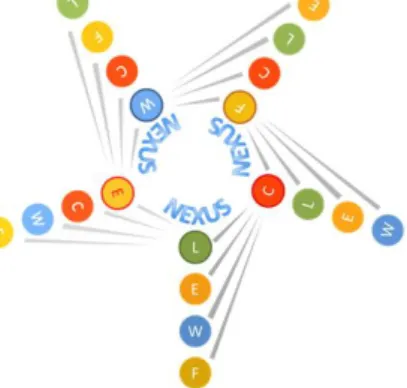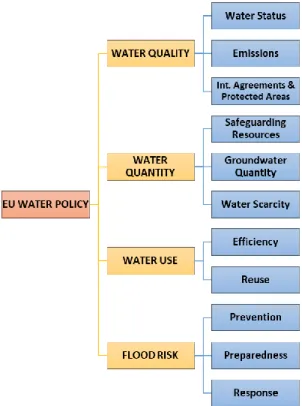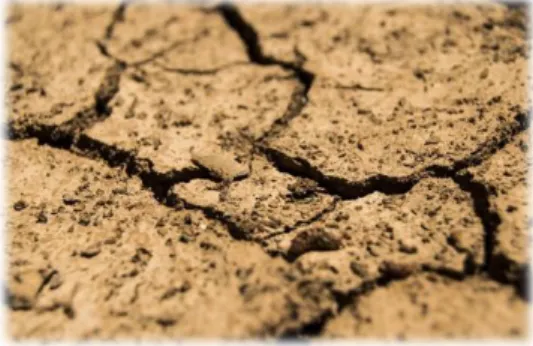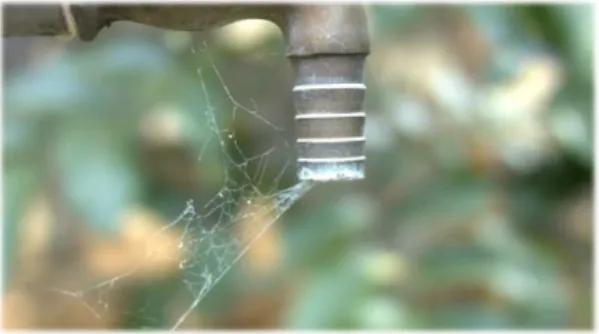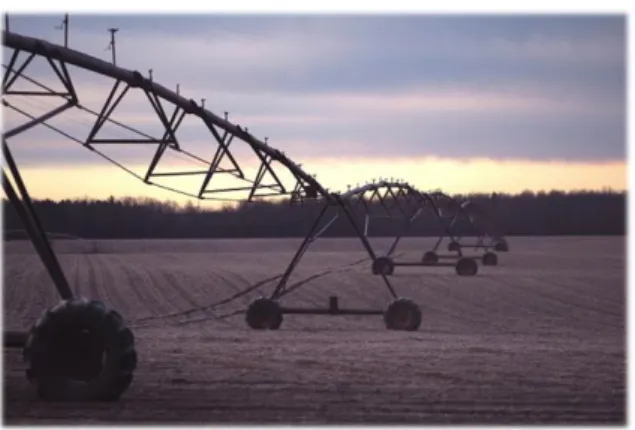Key mes s ages
At the European Union level, there is a strong policy coherence between water policies and those on land, agriculture, energy and climate. More advantage could be taken of synergies between these policies in implementation on national, regional and local levels. Coherence between these policies, therefore, needs more attention, during their planning and implementation.
The policy coherence issues related to the nexus between water, land, energy, food and climate, as observed on an EU level, can also be observed on national and regional levels. Those most relevant for water policies are:
1. Synergy: Good practices in water and land management generate positive effects in catchment areas: restoration of natural courses of rivers, soils and infiltration capacity, prevention of soil erosion and reforestation are nature-based solutions to combat flooding and drought and are synergistic with climate change mitigation and adaptation. These synergies were confirmed by cases in the Czech Republic, Slovakia, Germany, Andalusia, and South West England.
2. Synergy: Increasing energy and water efficiency, resource efficiency in the agro‐food chain, and reduction in the use of water and energy are fundamental measures that serve all sectors within the nexus and are synergistic with climate change mitigation and adaptation. These synergies were mentioned in the cases in Greece, Latvia, Andalusia and Sardinia.
3. Ambiguity: Water supply and management of flooding and drought may have positive effects within the nexus. However, increases in the water supply may increase energy demand and cause rebound effects, as was mentioned in the cases in Andalusia, Sardinia and Greece. Nature-based solutions, such as soil restoration, reforestation, creating marshes and patches of natural areas to restore local hydrology, have more synergy with land management and climate change mitigation than do pure technical solutions, such as canals, artificial reservoirs and pumps, as described in the Czech and Slovakian cases.
4. Conflict: Competition for scarce water and land, confirmed by cases in the Netherlands, Czech Republic, Germany and the Upper-Rhine basin in Germany and France.
5. Conflict: Production of first-generation biofuel crops, stimulated by European and national renewable energy policy, may create negative trade-offs. Large-scale monoculture changes the agricultural landscape, regional hydrology and local climate, as mentioned in the cases in the Czech Republic, Slovakia and Germany.
IMPLEMENTATION OF EU WATER POLICIES
MAY BENEFIT FROM SYNERGIES WITHIN THE
NEXUS BETWEEN WATER, ENERGY, LAND,
FOOD AND CLIMATE
The SIM4NEXUS Hori z on 2020 proj ect
The SIM4NEXUS project has mapped and analysed the policy coherence between the current European, national and regional policies on water, land, agriculture and food, energy and climate, in nine case studies, covering Greece, Latvia, the Netherlands, Sweden, Andalusia (Spain), Sardinia (Italy), South-West England (United Kingdom) and two transboundary areas including the Czech Republic, Slovakia and Germany; and the Upper-Rhine
basin in Germany and France.
Water, land, food, energy, and climate are interconnected, comprising a coherent system (the ‘Nexus’), dominated by complexity and feedback (see Figure 11). Putting pressure on or solving problems in one part of the Nexus may
create pressures in one or more of the others. Management of the Nexus is critical to securing the efficient use of our scarce resources. With the use of the model, SIM4NEXUS aims to assess long-term society-wide impacts of resource use and policies in the above-mentioned sectors. Interconnections between the sectors in de nexus will be demonstrated in serious games.
Polic y c oherenc e
Policy coherence, here, is the result of systematic efforts to reduce conflict and promote synergies within and between individual policy areas at various administrative and spatial scales234. The investigation of policy in the SIM4NEXUS project focuses on the analysis of the coherence between policy objectives and instruments related to water, land, energy, food and climate.
Policy synergy is achieved when the combined efforts of two or more policies accomplish more than the sum of the separate results from each policy. Policies, thus, reinforce each other. For example, the combination of investment in research and innovative pilot projects with a clear emission target may boost innovation and the uptake of new clean technologies, whereas investments without a clear target or a target without related investments would not be as effective.
Policy conflict arises when the goals and instruments of one policy impede those of another. When conflicts arise, choices should be made about the related trade-offs. This implies choosing to reduce or postpone one or more desirable outcomes in exchange for increasing or obtaining other desirable outcomes. This choice requires political compromise, such as revision of objectives that have become unfeasible, spatial segmentation of conflicting activities, mitigating negative impacts of the dominant policy on other interests, implementation strategies that minimise trade-offs, and compensation for the injured parties. For these choices to be made, first of all, conflicts between policies need to be identified and analysed. Coherent policy does not mean the absence of conflict, but rather refers to a policy that finds solutions for any conflicts, in a transparent way.
Policy coherence between policy documents is not a guarantee for coherence in practice, as was stated by stakeholders in the Greek, Latvian and German‐French cases. The other way around, policy conflicts ‘on paper’ could turn out more synergistic in practice, as was noted by Swedish stakeholders about the conflicting relationship between agricultural economic and overall environmental policies.
1 Laspidou, C. et al. (2017): D1.1 Scientific Inventory of the Nexus. SIM4NEXUS Deliverable. Available at:
https://www.sim4nexus.eu/userfiles/Deliverables/D1.1%20Final%20submitted%20v03.pdf
2Munaretto, S., & Witmer, M. (2017). D2.1 Water‐Land‐Energy‐Food‐Climate Nexus: Policies and Policy Coherence at European and
International Scale. The Hague: SIM4NEXUS; PBL Netherlands Environmental Assessment Agency.
https://www.sim4nexus.eu/page.php?wert=Deliverables#collapse107
3 Nilsson, Mans, Griggs, D., & Visbeck, M. (2016). Map the interactions between sustainable development goals. Nature, 534(7607),
320–323.
4 Nilsson, Måns, Zamparutti, T., Petersen, J. E., Nykvist, B., Rudberg, P., & McGuinn, J. (2012). Understanding policy coherence: analytical
framework and examples of sector–environment policy interactions in the EU. Environmental Policy and Governance, 22(6), 395–423.
Vertic al polic y c oherence: Barri ers to the impl ementation
of EU water poli ci es i n Member States
Because of the socio‐economic and bio‐physical differences and differences in governance, the implementation of framework policies may be received and play out differently in the Member States. Also, policy incoherence at an EU level may hamper implementation on national and regional scales, because conflicts between policies only manifest themselves after policy implementation.
The following barriers to the implementation of EU water policies in Member States were identified in the cases of the SIM4NEXUS project:
1. Incoherence at an EU level hampers implementation, such as:
• In the Czech Republic, national financial support in the production of energy crops driven by the EU Renewable Energy Directive is hampering the achievement of the EU good water quality objectives.
2. Limited EU policy support for national issues, such as:
• In the Czech Republic, EU water legislation does not address issues related to water retention in the landscape. In addition, only a few farmers are using the funds of the Rural Development Programme (second pillar of the CAP) because of the administrative burden of the application and accountability process.
3. Lack of coordination of implementation efforts in Member States, such as:
• In Sweden, the Water Framework Directive has been only partially implemented due to limited coordination around the implementation of the Directive on Flood protection and the Groundwater Directive.
• In Sweden, a lack of coordination between various sectors affects water management. Water authorities have no control over forestry authorities or municipalities on water issues. Voluntary collaboration is not sufficient. 4. Lack of manpower, funding and knowledge, such as:
• In Latvia, the implementation of River basin management plans is challenged by a lack of manpower and insufficient knowledge of the impact of measures already implemented, due to poor monitoring and evaluation. Among the parties who need to act, this creates resistance to new measures.
5. Transboundary differences in governance structures, such as:
• In the Upper-Rhine basin, it can be difficult to identify the appropriate counterparts at the other side of the border for interaction on certain subjects, which complicates transboundary cooperation.
6. Lack of financial resources for shared transboundary projects, such as:
• In the Upper-Rhine basin, difficulties in obtaining financial resources for transboundary projects and research were mentioned as a problem. However, the available budget is not always fully utilised by the eligible partners, due to disagreements on project design and implementation.
Horiz ontal polic y c oherenc e
The EU level
Several European directives, action plans and strategy documents regulate four key policy sub‐systems in the water domain, namely: water quality, water quantity, water use and flood risk. These directives and plans include the EU Water Framework Directive, the Groundwater Directive, the Urban Waste Water Directive and the EU action plans for Circular Economy, on Water Scarcity and Droughts—including the Blueprint for Water—and its follow-up actions, such as on wastewater reuse. The Floods Directive, the 2016 Action Plan on the Sendai Framework for Disaster Risk Reduction and the EU Parliament and Council decision on the European Union Civil Protection Mechanism are concerned with flood risk, prevention, preparedness and response.
Figure 3 Four key policy sub‐systems in the water domain, namely: water quality, water quantity, water use and flood risk
The following water objectives were chosen to analyse the horizontal policy coherence in the nexus between water, land, energy, food and climate:
Achieve at least good water status for each river basin and good groundwater status by 2027
Ensure sufficient supply of good quality surface water and groundwater for people, the economy and the environment Safe and cost-effective water reuse
Address and mitigate water scarcity and drought in the EU Address flood risks and the consequences of flooding in the EU
Synergy
These water objectives are predominantly synergistic with the objectives for land, energy, food and climate, as they support the sustainable use of resources, economic activities, climate change resilience and the provision of ecosystem services. The other way round, numerous policies for the other sectors positively influence the water objectives; for example, reducing energy consumption helps to address water scarcity and drought, as this would mean that less water will need to be used to produce energy.
Conflicts
Some policies in the nexus may negatively affect water objectives. For example, the production of biofuel crops may cause water pollution and scarcity, and hydropower may impede a good ecological status of rivers. Also, economic policy for the agricultural sector may negatively affect water objectives if environmental standards are not met. In these cases, progress in achieving energy, agriculture and climate objectives comes at the expense of water objectives. These conflicts between objectives are not always mentioned in policy documents. For example, in the Renewable Energy Directive II 5, negative effects of hydropower on aquatic ecosystems, water quality and water quantity are not addressed, and the effects on water inside and outside the EU are addressed less strictly than those on land. Negative effects on water quality from the production of biofuel crops within the EU are accounted for in the CAP and environmental legislation, but effects on water quantity are not addressed. Also, if biofuel production causes deforestation, the risks of flooding and drought may increase—an indirect negative effect on water management and climate change adaptation.
National and regional levels
The national, regional and transboundary cases of the SIM4NEXUS project have analysed the horizontal coherence between a selection of policies on water, energy, land, agriculture, food, and climate, insofar those were relevant to the particular case. Most of the policy objectives are directly related to EU policies. There are more synergies than conflicts between the selected policy objectives, as was also found at the EU level. However, policy coherence in policy documents is not a guarantee for coherence in practice. Stakeholders mentioned conflicting interests during implementation, examples of which include competing claims on water and land, ambiguous effects of expanding agriculture, biomass production and developing hydropower, and failure to implement environmental and landscape policies because of dominant economic objectives.
The cases also described the local arrangements for cross‐sectoral coordination and cooperation. Common interests and shared goals are important enabling factors for these arrangements. Reaching an understanding and agreement on shared interests and goals is time-consuming and requires a great deal of manpower and funding, which, however, pays off in terms of avoided deadlocks and conflicts in the implementation of policies. A crucial factor for regional cooperation is the presence of financial resources to implement joint projects or start joint initiatives with a long‐term horizon. Furthermore, the possibility of economic gains is also a driver of cooperation. The main hindering factors mentioned are unaddressed negative trade‐offs, insufficient support from the regional government, not fully explored common interests, competing plans and cuts in subsidies.
5 https://eur-lex.europa.eu/legal-content/EN/TXT/PDF/?uri=CELEX:32018L2001&from=en.
Figure 5 Negative interactions in the Nexus are due to producing 1st generation biofuel crops
Figure 4 Reducing energy consumption helps to address water scarcity and drought
At the national and regional levels, the following horizontal synergies and conflicts were identified:
In Greece, conflicts arise from the allocation of scarce water resources during the summer season. Water is reported to be overused for irrigation, mainly by the agricultural sector. Farmers also complain if scarce water is allocated to environmental flow. Policies that subsidise water‐intensive crops, such as cotton, conflict with those on the sustainable management of water resources that promote crop restructuring to reduce additional pressure on water resources. The Greek Government provides energy subsidies for irrigation to farmers to boost agriculture and food production. This does not stimulate energy and water saving and efficiency. Moreover, as agricultural water in Greece is provided free‐of‐charge to farmers, there are no incentives for the farmers to minimise water losses. Finally, pollution caused by the use of pesticides also deteriorates water quality.
In Latvia, expansion and intensification of agriculture to increase the production of biomass is mentioned as a severe problem for water, land and even climate objectives. Expansion of arable land at the cost of forest, natural and semi-natural meadows, and the intensification of fertilizer use on existing arable land to increase yields of food or feed crops, conflict with climate change mitigation targets (greenhouse gas emissions and carbon sequestration) and have a negative impact on soil and water quality through the run-off of nutrients, pesticides
and herbicides. It also reduces the amount of land available for other agricultural production, causes fragmentation and degradation of land and deteriorates ecosystems and biodiversity—thus, reducing the ability for adaptation to climate change. In addition, energy generated through hydropower helps to achieve targets for the use of renewable energy but has a negative impact on water quality and ecosystems and lays spatial claims on land. Implementation of the River Basin Management Plans is hampered by a lack of manpower, funding, and fragmented background data. In addition, substandard monitoring and evaluation lead to insufficient knowledge of the impacts of measures already implemented. Among the parties that need to act, this creates resistance towards new measures.
In the Netherlands, stakeholders mention compliance with rules
and regulations across multiple policy sectors as a problem, such as in relation to EU policies on nature (Natura2000), agriculture (CAP) and water (Water Framework Directive). Intensive arable and livestock farming counteract the improvement in water quality and ecosystems.
In Sweden, good quality surface water, groundwater and wetlands seem to be difficult to achieve, as long as agricultural and forestry production both dominate. This is reflected, in recent years, by the failure to implement most of Sweden’s Environmental Quality Objectives. Higher priority has been given to the intensification of production that does not support high biodiversity or the improvement of water quality. In addition, the highest priority is awarded to climate change goals, which are not always in line with other environmental objectives. The implementation of the Water Framework Directive faces a lack of coordination between various sectors, affecting water management. Water authorities have no control over forestry authorities or municipalities. Although there is some effort to coordinate water‐related activities in the various sectors, voluntary collaboration is not sufficient. Similar coordination issues exist for the implementation of the Groundwater Directive.
Figure 6: Competition for scarce water exists in Greece, Czech Republic, Slovakia, Germany and Sardinia , Czech Republic, Slovakia, Germany and Sardinia
In Andalucía (Spain), a national irrigation plan is being implemented that aims to consolidate, modernise and expand the existing irrigated infrastructure. Rationing water use to ensure long-term water supply supports irrigation efficiency and enables sustainable competitiveness of the Andalusian agricultural and agro‐industrial sector. Progress in modernising existing irrigation systems may have positive effects on other objectives in the water domain, but has largely negative effects on energy and climate, due to the increased energy use in modernised irrigation systems, regeneration and the desalinisation of water. The Spanish water delivery system switched from surface irrigation systems to pressurised systems, which is more water-efficient but also more energy-consuming. High energy costs are a big challenge for farmers. Energy subsidies for irrigation stopped in 2008.
In Sardinia (Italy), water demand in agriculture competes with water for domestic use, in tourism and hydropower production. An increase in any of these economic activities, if not supported by measures to reduce and limit water consumption, causes an increase in water demand and competition. Interviewees frequently reported a lack of water-use regulations for all sectors. Stimulating resource efficiency along the agro‐food chain and in forestry is positively linked with nearly all other policy objectives within the nexus.
In South West England (SWE, United Kingdom), agriculture is an important sector, and its diffuse pollution forms a threat to water quality. National policy does not tackle this problem as effectively as it does point source pollution by wastewater. South West Water, the regional water provider, recognises that it is cheaper to help farmers deliver cleaner raw water to rivers and streams than it is to pay for the expensive filtration equipment required to treat polluted water after it has been abstracted from the river and make it suitable for drinking. As a result, the Upstream Thinking partnership was initiated with the aim of improving raw water quality and water storage in
the natural landscape to make the provision of drinking water more sustainable. Objectives concerning the sustainable delivery of water are positively linked to objectives for land use, climate change mitigation and adaptation. Stakeholders noted that regulation to improve water quality in catchments, enforced by the National Environment Agency, can be at odds with local cost efficiencies. This may lead to a downward spiral in policy implementation in cases of limited dialogue. Also, the agri-environment schemes of the CAP decrease in popularity among farmers and landowners, because of detailed regulations, variability of payments, lack of coordination and cooperation between authorities, and uncertainty about the future after a Brexit.
In the Czech Republic and Slovakia, progress in the water sector could positively influence land and soil, agriculture and climate mitigation and adaptation, if water management would also focus on land management, such as the restoration of the landscape, including its local water regime and small water cycles. Land and soil objectives that focus on improving soil quality, land ownership and landscape structure, resonate well with water and climate objectives. The EU Renewable Energy Directive, which has been fully integrated into national legislation, stimulates biofuel production and the use of biomass as a renewable resource, at the expense of soil quality and the local water regime. This leads to large-scale monoculture and degradation of the agricultural landscape, soil and local hydrology. Water retention in agricultural land is rapidly decreasing. There is a conflict between the need to reduce the size of the parcels of farmland and reintroduce nature elements in the landscape to improve soil quality and water retention, on the one hand, and the need of farmers to work highly efficiently to remain competitive in the market, which stimulates large-scale agriculture, on the other. EU water legislation does not address issues related to water retention in the landscape, a major problem in the Czech Republic and Slovakia.
Figure 8 Modernising existing irrigation systems
In Germany, implementation of the Water Framework Directive encounters difficulties, especially in the funding phases of projects, when diffuse responsibilities make it difficult to identify whether projects should be funded by the national government or by the federal states. In general, the main impact of these difficulties consists of delays in implementation. Also, agricultural production conflicts with the desire to reduce the pollution of water bodies, since fertilizers are one of the main sources of pollution.
Methodological note
For the SIM4NEXUS case studies, policy documents were selected for their area and an overview was made of policy objectives and instruments relevant for their research focus. The national case studies analysed how these objectives would be related to international multilateral agreements and to European policies. The regional cases investigated the relationship between national and regional policies, the case of the Upper-Rhine basin Germany‐France looked at transboundary policies. All the cases also analysed horizontal coherence between policies of various sectors, analysing policy documents and consulting stakeholders to learn about coherence issues in practice.
This policy brief includes the main findings of the project, so far. Further details can be found in several project reports, including ‘Water-Land-Energy-Food-Climate Nexus: Policies and Policy Coherence at European and International Scale’6 and ‘Nexus‐relevant policies in the transboundary, national and regional case studies’7.
Implementation of EU Water Policies may benefit from synergies within the nexus between water, energy, land, food and climate, April 2019. Author: Maria Witmer, PBL Netherlands Environmental Assessment Agency. Contact: Maria.Witmer@pbl.nl. Edited by PBL and Fresh Thoughts Consulting GmbH.
6 https://www.sim4nexus.eu/page.php?wert=Deliverables#collapse107
7https://www.sim4nexus.eu/page.php?wert=Deliverables#collapse169
